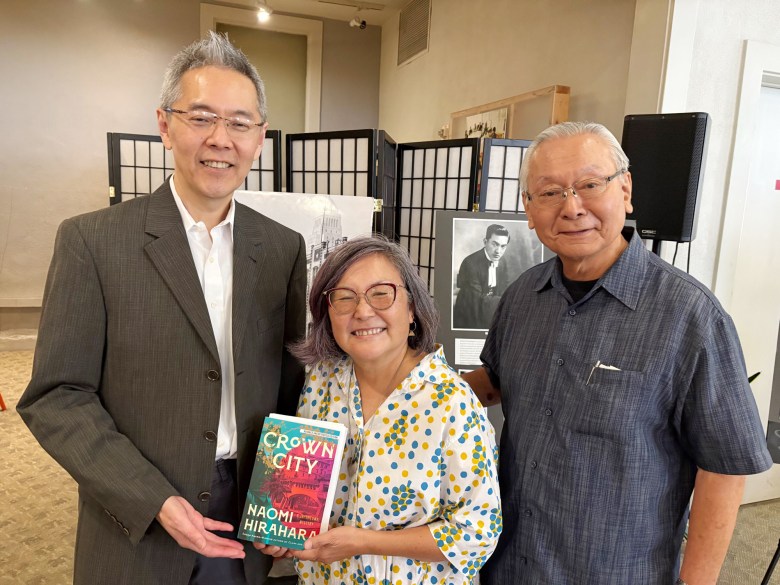 Photo by J.K. YAMAMOTO / Rafu Shimpo
Photo by J.K. YAMAMOTO / Rafu Shimpo
From left: Bradly Hammond of LTHS, Kristen Hayashi of JANM, and Bill Watanabe of LTHS with a century-old photo of Fuji-kan.
RAFU STAFF REPORT
A sign designating the Fuji-kan Theater Historic-Cultural Monument in Little Tokyo was unveiled with a brief ceremony on Oct. 30.
The program was presented by the Little Tokyo Historical Society in partnership with the Japanese American National Museum, with sponsorship by Aratani CARE Grant and the the Arts District Little Tokyo Neighborhood Council Neighbor-hood Purpose Grant.
 Members of the Little Tokyo Historical Society gather underneath the newly unveiled historical marker.
Members of the Little Tokyo Historical Society gather underneath the newly unveiled historical marker.
Opening remarks were made by LTHS board member Bill Watanabe, followed by greetings from Consul Aya Ishii on behalf of the Consulate General of Japan in Los Angeles, Little Tokyo Business Association President David Ikegami, and Dylan
Stickland from the office of City Councilmember Ysabel Jurado of the 14th District, which includes Little Tokyo. Kelli Lloyd also represented Jurado.
The Fuji-kan opened on Oct. 20, 1925 at 324 E. First St. The sign was placed near the site of the original building, which was demolished in 1964.
The sign, which bears the City of Los Angeles seal, reads: “Fuji-kan Theater, 324 E. First Street – 1925. Oscar-nominated silent movie star Sessue Hayakawa discovered in Little Tokyo. Little Tokyo Historical Society, 2025.”
 Paul and Ann Abe attended the unveiling. Ann is the granddaughter of one of the co-owners of Fuji-kan.
Paul and Ann Abe attended the unveiling. Ann is the granddaughter of one of the co-owners of Fuji-kan.
Ann Abe was recognized as the granddaughter of Katsugoro Kawase, who co-owned the theater with Yasuasaburo Fujimoto.
Professor Daisuke Miyao of UC San Diego, author of “Sessue Hayakawa: Silent Cinema and Transnational Stardom,” spoke about Hayakawa (1886-1973), who got his start on the theater stage in Little Tokyo in a play, “The Typhoon,” was hired by producer Thomas Ince to star in a silent movie version with the same title, then was signed by Famous Players-Lasky to star in “The Cheat“ (1915), directed by Cecil B. DeMille.
 Professor Daisuke Miyao gave a presentation on the career of actor Sessue Hayakawa.
Professor Daisuke Miyao gave a presentation on the career of actor Sessue Hayakawa.
Many films starring Hayakawa, who became a matinee idol, were later shown at the Fuji-kan.
The theater started out by showing American silent movies, then began showing Japanese silent movies when it reopened in 1926. A benshi or on-site narrator often spoke during the screenings. Fuji-kan continued to operate until 1941, just before the mass incarceration of Japanese Americans. It reopened in 1945 as the Linda Lea, which moved to Main Street about a decade later.
The family that operated Fuji-kan before the war reacquired the building on First Street and opened it as the Nichibei Kinema in 1955. Japanese movie stars sometimes attended openings of their films in conjunction with Nisei Week. The Kinema operated until 1963 and was evicted when the property was acquired for redevelopment.
The unveiling was followed by a reception at JANM’s Democracy Lab. Attendees were welcomed by LTHS board member Bradly Hammond and Miyao gave a more detailed presentation about Hayakawa, who received an Oscar nomination for best supporting actor for his portrayal of Col. Saito in “The Bridge on the River Kwai” (1957).
 From left: Professor Daisuke Miyao, mystery author Naomi Hirahara and Bill Watanabe of LTHS at JANM’s Democracy Center. A photo of Sessue Hayakawa is in the background.
From left: Professor Daisuke Miyao, mystery author Naomi Hirahara and Bill Watanabe of LTHS at JANM’s Democracy Center. A photo of Sessue Hayakawa is in the background.
Also present was mystery author Naomi Hirahara, whose latest novel, “Crown City,” is set in turn-of-the-century Pasadena and features real-life historical figures, including Hayakawa’s future wife and co-star, Tsuru Aoki.
Lunch was provided by Don Tahara of Far Bar. Attendees also received “retro candy” from the 1920s, including Tootsie Rolls, Mary Janes, Charleston Chew, Milky Way and Bit-o-Honey.
Articles for you


AloJapan.com